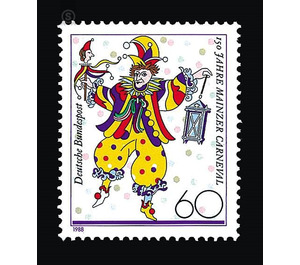150 years Mainz Carnival - Germany / Federal Republic of Germany 1988 - 60 Pfennig
Theme: Art & Culture
| Country | Germany / Federal Republic of Germany |
| Issue Date | 1988 |
| Face Value | 60.00 |
| Color | multi-colored white |
| Perforation | K 13 3/4: 14 |
| Printing Type | Multicolor offset printing |
| Stamp Type | Postage stamp |
| Item Type | Stamp |
| Chronological Issue Number | 1222 |
| Chronological Chapter | GER-BRD |
| SID | 398898 |
| In 50 Wishlists | |
The carnival, carnival, as it is called here, is the Mainz folk festival, the 5th season of Mainz, a piece of town history, a cultural-historical phenomenon. With the transmission by the mass media, the festival grew out of its local limits, so that today three quarters of all Germans identify Mainz with the carnival. However, anyone who thinks that Mainz always voted almost nightly is wrong. Between Ash Wednesday and Martini, the sounds of the fool's harp march are silent. At Eleventh to Eleventh, for the first time, they hesitantly sound up to silence until the first day of the new year. At the New Year's parade of the Garden, they blow to the overture of the campaign and accompany the foolish meetings for a few weeks. On Shrove Saturday they are also heard in the streets. They then dominate the city until they fall silent for a quarter of a year in the last hour of Shrove Tuesday. But even at their peak, they do not seduce into exhilarating intoxication, but they tune in to contemplative or exhilarating cheerfulness. The roots of Carnival date back to history; It received its present form at the time of the German Vormärz, as the 18 years before the March Revolution of 1848 are called, in which restorative governments tried to hinder the development of the strengthened bourgeoisie. A forum of civic activity formed the clubs that sprang up since the wars of liberation and offered the opportunity to organize sports, art, science and conviviality - even Carnival, which was celebrated by the wealthy with glittering balls, by the simple people in pubs and on streets was celebrated. In 1823 they were the first to organize citizens of Cologne. Mainz followed in 1838, after a year before a "Krähwinklerzug," a persiflage on the Kleingeisterei, had moved through the streets of Mainz, led by the new Ranzengarde. On January 19, 1838, 100 Mainz citizens, mainly from the middle class, signed the statutes of the Mainz Carnival Association, which had set itself the goal of serving the Prince Carnival "in better order and nobler taste." The modern Mainz Carnival was born. The "foolish world" showed itself in a new form appropriate to the bourgeois era. With the "Comité" and its three-stage election, with the "Lectures," with the "General Assembly," with the "Orders," and with the appearance of Prince Carnival and his household, the associations that had made the reform possible, as well as the political conditions. The foolish reversal also served the four-colored fool banner and the club crest. By mixing late-absolutist symbols with symbols of the French Revolution, the founders responded to German petty-bourgeoisie and cleverly recalled their temporary allegiance to revolutionary France, just as the people of Cologne had reminded them of their affiliation with Prussia. Protected by the fool's cap, hidden behind polished verses, the speakers broke through the ubiquitous censorship; the political-literary expression of Mainz carnival had found its form. An essential element of the Reformed carnival were the meetings and the street carnival, which was limited to the three days before Ash Wednesday, and this also received as the sessions, a solid program with theater performance, recruiting, Rosenmontagszug and cape ride. Ceremonial and expiration of the carnival remained unchanged until today; however, more than 50 clubs and guards joined the MCV and the Ranzengarde over the years. However, MCV remained the highest representative of the carnival. He organizes the carnival procession, selects the prince and groom - which is only available on special occasions in Mainz -, celebrates the carnival epiphany and is responsible for the New Year's parade of the Garden and the cape on Shrove Tuesday. The 120 meetings organized by more than 30 clubs and guards during a campaign are attended by around 70,000 fools. When the weather is favorable, 500,000 people see the Rose Monday procession on the spot, many millions see it on the screen - evidence of the vitality, the convivial and cultural charisma, as well as the economic importance of Mainz Carnival and the jubilant MCV. (Text: Friedrich Schütz, senior archivist at the city archives Mainz)


